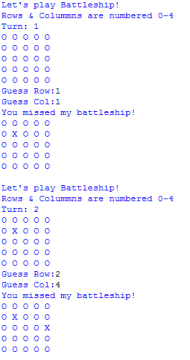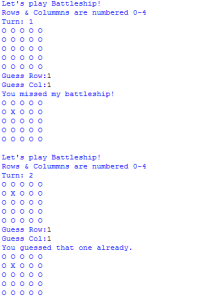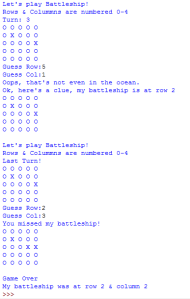Like classic Battleship? Well then this simplified version might, possibly, maybe grab your attention!
On a serious note though, I’ve done a simple version of Battleship in Python, the code is easy to follow and the idea’s in the code can be used for other things such as a word search!
Below is the source code and I will talk you through the important snippets of code!
# Possibly change this to be more user friendly e.g. 1-5
from random import randint
board = []
for x in range(5):
board.append(["O"] * 5)
def print_board(board):
for row in board:
print " ".join(row)
""" .join() combimes the items in the list taking each individual item at a time,
in this case printing it with a space after it."""
def random_row(board):
return randint(0, len(board) - 1)
def random_col(board):
return randint(0, len(board[0]) - 1)
ship_row = random_row(board)
ship_col = random_col(board)
for turn in range(4):
print "Let's play Battleship!"
print "Rows & Colummns are numbered 0-4"
if(turn+1 == 4):
print "Last Turn!"
else:
print "Turn: %s" %(turn +1)
print_board(board)
# print ship_row
# print ship_col
"""Above prints the position of the ship on the screen for debugging purposes"""
# Everything from here on should go in your for loop!
# Be sure to indent four spaces!
guess_row = int(raw_input("Guess Row:"))
guess_col = int(raw_input("Guess Col:"))
if guess_row == ship_row and guess_col == ship_col:
print "Congratulations! You sunk my battleship!"
break
else:
if (guess_row < 0 or guess_row > 4) or (guess_col < 0 or guess_col > 4):
print "Oops, that's not even in the ocean."
elif(board[guess_row][guess_col] == "X"):
print "You guessed that one already."
else:
print "You missed my battleship!"
board[guess_row][guess_col] ="X"
if(turn+1 == 3):
print"Ok, here's a clue, my battleship is at row %s" %(ship_row)
print_board(board)
print ""
if(turn == 3):
print "Game Over"
print "My battleship was at row %s & column %s" %(ship_row, ship_col)
- We import randint from the random module so we can use the function randint.
from random import randint
- We then create an empty list called board. First we fill it with [“O”,”O”,”O”,”O”,”O”] five times with our for loop. Then we join the individual parts of the list to form a grid full of “O”s.
for x in range(5): board.append(["O"] * 5) def print_board(board): for row in board: print " ".join(row) - In the method “print_board”, the join() function combines the individual parts of each list in the “master_list” (i.e. board) together to form a grid. (See fig.1). If the programmer was to use a “-” before the join instead of ” ” it would result in a grid displayed in fig.2.
- After the creation of the grid the rest of the program is if and else statements in a for loop. The for loop allows the “player”/ “end user” to guess 4 times on the location of the battleship, taking input from the user each time.
for turn in range(4): #more code here #Below we take input from end user guess_row = int(raw_input("Guess Row:")) guess_col = int(raw_input("Guess Col:"))Below are images of game play:

Regular game play. 
Already guessed error. 
Out of bounds error and failed ending.



